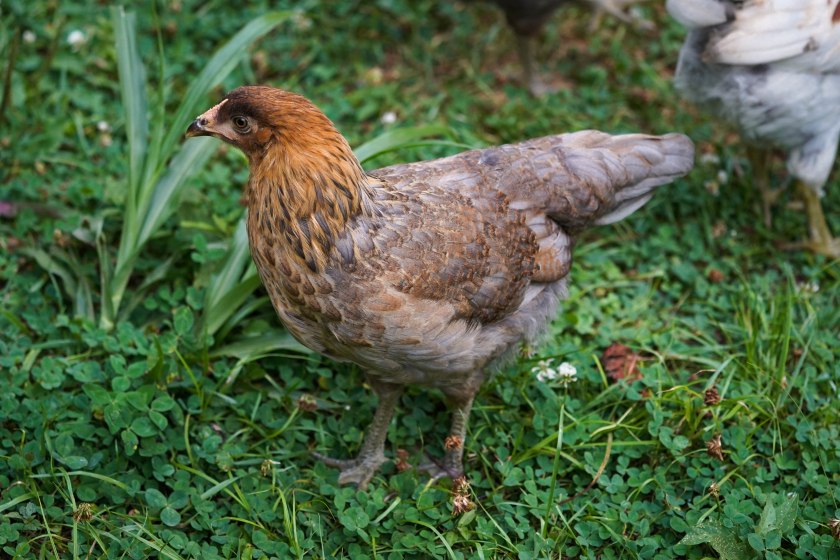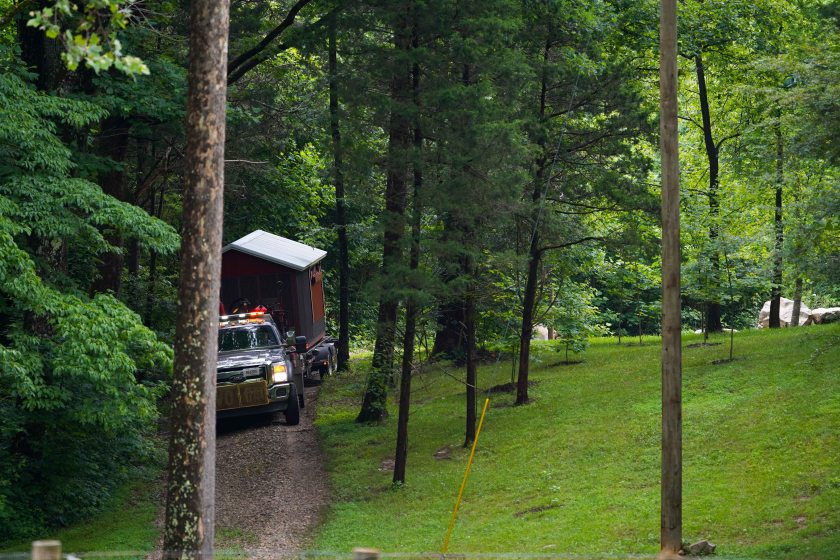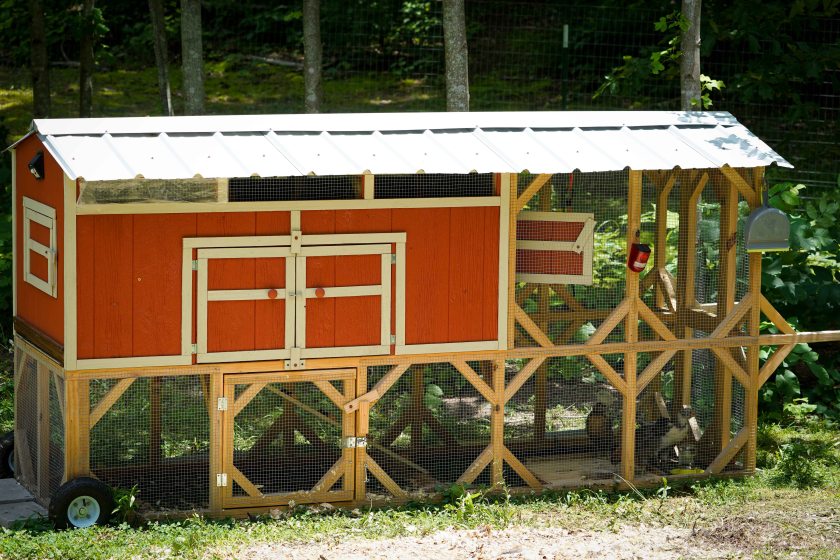by Beth
It’s been a wild month with chickens! From a new coop, to a calmer rooster, to breakfast.
Also, the Easter Eggers have names. It took a while to settle on these. I kept trying to figure out a theme (e.g., characters in a movie or candy you’d find in an Easter basket…Heath, Snickers, Twix, Zagnut…), but chickens seem to name themselves. Here goes:
This is Raisin. She looks like black and golden raisins. Almost named her Goldie Bok-Hawn. Just try to keep her off your lap.


Here’s Carrots.

If she’s not with Raisin, you’ll find Carrots about to get pecked by Cogburn or Stilton. Maybe she’s a target because her head’s so orange, or maybe she’s just keeps walking into their beaks. I wanted to name her Chipmunk or Cheeks, but neither is a good name. She has the only special Easter Egger muffs/beard of the pullets in this group.
The surprise cockerel is Stilton. His feather pattern looks like a chunk of blue cheese, and cockerel chicks look like they’re on stilts.


I reserve the right to change his name to Lars; he looks like a Lars. He also has the nice, puffy muffs and beard, which is why he’s here. He and Carrots were the only 2 chicks with puffy cheeks. I really wanted chickens with puffy cheeks, sigh.
And Ashley, because her down is the color of wood ash.

Her other names have been Apple, Annie, Shortcake, Ladybird, and Mean Matilda, but Ashley stuck. As a tiny chick, she was flighty and standoffish until the day she flew out of the brooder and couldn’t find her way back. She’s been a snuggler since the moment I returned her to the safety of the brooder bin. Still sassy, though, and currently head hen of the EE bunch. You’ll find her next to Stilton.

New coop is here.
At the beginning of week 18, we were moving chickens into the new coop, finally. The coop was promised in 5 weeks but took nearly 10 weeks to arrive. It would’ve been later if the delivery people hadn’t been willing to defy a stormy weather forecast. The radar showed the kind of rain that would’ve made it tricky to deliver a big building on a truck. The storms mercifully never materialized, and delivery went perfectly. One reason we chose this vendor was their excellent drivers.

We ripped down fencing and hawk strings and reinstalled everything after the driver expertly placed the coop in the run. It blends into the scenery nicely.

For 2 days, the big chickens explored the coop as we customized it with flooring mats, feeders and waterers, stronger wire mesh over the windows, hooks to hold doors and cleaning supplies, etc.

Future upgrades include a wire apron around the outside, more trimwork, and some cute signage. Since these photos were taken, Chris built a sweet roosting ladder on the left side to reduce pecking-order issues when we eventually transition new chickens into the coop.
On the third evening, I sprinkled oats up the ramp and convinced each Brahma and Langshan pullet to waddle up into the coop (Cogburn still sleeps in his cabin), then snuck around through the human door and sat with them until each settled on a roosting spot, after plenty of discussion.

They seemed confused about why the space was so big in contrast to the tractor coop, but their main focus was procuring a window seat at each end of the roost. I’d read the ends of the roost were for the lowest in the pecking order, but that doesn’t apply when a coop has windows at each end of the roosts and your posh chickens like a breeze and a view.
Easter Egger chicks moved outside full-time at 6 weeks.
After scrubbing the tractor coop, I transitioned the Easter Egger chicks outside full time over several nights.

The first night, I really wanted to leave them out, but as the sun set, these bold, rambunctious chicks were squeaking in desperation to get to the dog crate and go “home.” I opened the tractor to comfort them, and they rushed me, jumping on my lap and hiding their heads in my elbows. Of course I brought them inside.
As soon as I opened the dog crate back in the study, the chicks filed into the brooder bin and crashed out. The scene repeated itself the next night, though I tried harder to leave them out, leaving them out longer and putting the brooder heating plate in the coop to make them feel at home. They weren’t having it.
The next night, I let them run out and snuggle into my lap at dusk. After they ran into the dog crate, I covered the coop’s floor hole with smooth plywood, then put food, grit, water, and the dog crate full of chicks in the coop. Since it was dark, they were in their sleepy state, not fully aware of what was going on. I quietly opened the crate, sprinkled bedding in with the drowsy chicks, and closed up the tractor. From that night, they were fine to sleep in the coop, though for the next 3 or 4 nights, they slept in or on top of the dog crate inside the coop.
The crate came out after they moved to the roosts, and now it sits in front of the tractor door, helping to block the bigger chickens from gaining entry. This gives the chicks a safe space to escape to when the big chickens are chasing them around the yard, since…
Integration of big and little chickens is in full swing.
Chickens don’t like change. Introducing new flock members takes finesse. There’s a high risk for pecking-order injuries, especially if one group is much younger or different looking. PoultryDVM.com has a great page of chicken infographics, like this one about adopting chickens: scroll down for ideas for introducing new chickens. We’re mixing the “gradual introduction” and “howdy” methods.
First, the 2 groups visited through the wire run of the tractor coop for a week. Then they shared the yard for a few supervised minutes an evening before one of the older birds would corner a chick and level a hard peck at it. Supposedly pecking order disputes can’t be prevented, just delayed, so it’s futile to intervene, but because the Easter Eggers are much younger and smaller and we have plenty of time and space for them to grow up before they integrate, I have no problem holding a big chicken back long enough to let a little one escape.

The only time I won’t step in is when Stilton the cockerel decides to stand up to the big pullets. I now know what roosters can turn into [Cogburn]. The guidance of annoyed hens is likely to help roosters develop into better birds, so those confrontations are important. If Stilton sees Cogburn, though, he knows to vamoose.
By the end of week 22, all the chickens could spend all day in the yard together without violence. The little ones had reliably learned to escape. Having big, heavy chickens + ample room meant the older chickens tired out before they could corner the chicks anyway. We do keep an eye out for hawks, but fortunately, so do the Easter Eggers. They’re savvy little things who easily disappear into underbrush.
The heat arrived.
Most of our summers aren’t too hot, but this July, temperatures are reaching the low 90s. Doesn’t sound bad when most of the country has 100°+, but our chickens start open-beak panting in the low 80s. I don’t know how people keep chickens anywhere hotter than this.

Luckily the chicken yard is at least half in the shade all day. Back when we were clearing the field, we left a few groves of young poplars, sweet gums, locusts, and black walnut trees. They look exquisite in the fall.
Working from home means I can take breaks to bring out treats like frozen blueberries and cold water and watermelon. Between that and the bodacious dust pits they’ve created in strategic spots around their yard, they seem fine. Here’s another great PoultryDVM infographic about chickens and heat.
Stilton started crowing at 8 weeks.
He sounds like a kazoo. Cogburn didn’t even try this until about 13 weeks.
While he may be crowing early because of Cogburn’s example, he’s not yet crowing in response to Cogburn, which would be competitive. Stilton is still humbled by Cogburn. For now.
Speaking of crowing…
There’s a mystery chicken through the woods.
I think. For several days, when Cogburn crowed, you could hear an exact echo of him through the woods. His crow is unique, so it’s strange another chicken anywhere could sound just like him, even more so because we haven’t heard about new roosters nearby.
Unfortunately, I’m the only one who has heard it, leaving me to question my sanity and whether our woods are haunted by chickens. I posted on a message board to ask if roosters can teach each other a specific crowing rhythm, and the consensus is yes, they can. So maybe there’s a cockerel nearby we’re not aware of who’s learning from Cogburn. Or maybe I’m more cuckoo than a Marans (a little chicken humor).

BUFF BRAHMAS ARE LAYING EGGS!!!
At 19 1/2 weeks, somebody laid an egg off the roost. It broke and then they ate it before I got there in the morning.
That was disappointing. After decades of wanting chickens and months of excited hand wringing over when our first chickens would lay first eggs, I wasn’t sure whether to cheer or cry. To complicate matters, people say egg-eating is such a bad habit you literally have to cull the hens who do it. Was this how things were going down? 2020 strikes again?
Rather than sink into my alarmism, I went online to find that many first eggs are laid off the roost because they surprise the layer. The consensus was that chickens will eat a broken egg if they find it, but that doesn’t mean they’ll destroy a lovely, whole egg in the nest. If they do, it’s a sign their diets and/or space need tweaking.
Just in case, I snagged the last set of brown, ceramic eggs at the feed store. These not only signal to chickens where to lay their eggs, they can reduce egg-eating tendencies because they don’t break when pecked.

Next, I spread 6″ of pine chips under their roost as a soft landing in case someone else was surprised again.

Nobody else has been surprised so far. The next day, Peep and Miss Eula could both be seen testing spots to lay eggs in, pecking the chips in each nesting box, sitting in them for a few minutes, then walking out. For the first week, Peep preferred to make a hen-sized dent in the soft-landing area under the roosts and lay her eggs there, while Eula rotated through the nesting boxes.
Eventually, Peep decided to use the boxes, too.
Their first eggs are small, which is good for beginning layers. Big eggs can hurt the bird. These ping-pong-ball-sized eggs are called “fairy,” “pullet,” or “fart eggs.” <–that last one is because of how they surprise the layer.
Fairy eggs can be yolkless, but we’ve eaten 8 so far, and each had a yolk. Except 2 with 2 yolks!

Eula and Peep laid double-yolks on the same day.
Younger hens’ reproductive systems can get confused and put 2 yolks in one egg. It’s a treat. The crazy thing is it happened to Peep and Eula on the same day, and then they went back to laying little eggs again. Pictures don’t show the egg sizes well, but Eula’s first double yolk is on the bottom right.

Cogburn is kinder.
Eggs have had a funny effect on the flock. Cogburn has become drastically nicer, particularly to the 2 laying. His behavior around eggs and nesting is so interesting, here’s a separate post about it.
The Brahmas and Langshans are 22 weeks at the end of this post, and the Easter Eggers are 10 weeks.

Beth, I’m just amazed at what all you know to do for chickens. This has been so interesting to read. And I love your names.
LikeLike